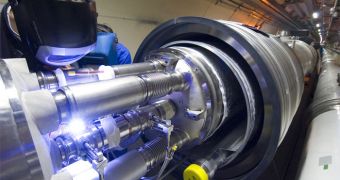The Worldwide LHC Computing Grid is ready to start the data challenge it has been built for: 15 million Gigabytes of data from the Large Hadron Collider will be analyzed and managed every year. Through the analysis of all this amount of data produced by the hundreds of millions of subatomic collisions expected inside the LHC every second, researchers hope to discover new physics. The LCG comes online three weeks after the LHC was powered up.
More than 140 computer centers in 33 countries join their IT power for the LCG. “Our ability to manage data at this scale is the product of several years of intense testing,” stated Ian Bird, leader of the Worldwide LHC Computing Grid project. “Today’s result demonstrates the excellent and successful collaboration we have enjoyed with countries all over the world. Without these international partnerships, such an achievement would be impossible.”
“The Worldwide LHC Computing Grid is a vital pillar of the LHC project,” said Jos Engelen, chief scientific officer for the LHC project. “It is an absolute necessity for analysis of the LHC data. It is the result of a ‘silent revolution’ in large scale computing over the last five years.”
“We are very happy to see the completion of this very long and intense development phase”, said Wolfgang von Rüden, head of CERN’s IT department. “I would like to acknowledge the excellent contributions by so many people all over the world in helping to complete this work on time and within budget.”
Dedicated optical fiber networks allow the LHC Computing Grid to distribute data from CERN to eleven major computer centers in Europe, North America and Asia. These centers then dispatch the data to more than 140 smaller centers situated around the world. Only through the close collaboration of these institutions the management of data transmitted by LHC is possible. Several weeks ago, we presented a few more technical details on this 15-petabyte network.
“We can routinely process 250,000 jobs a day,” said Bird, “and we can achieve peaks of 500,000 jobs without problems.” A single job can be a calculation lasting several hours or even several days on a single high performance processor. An estimated 100,000 processors are required to handle all the jobs from the LHC experiments.
The grid computing provides research capabilities for other areas of science besides physics as well. “The significance of the Worldwide LHC Computing Grid goes well beyond the LHC,” Bird noted. “Many other researchers and projects are already benefiting from the lessons learned here. Grid computing is enabling all-new ways of doing science where large data handling and analysis capabilities are required.”
Enabling Grids for E-Science (EGEE) in Europe and Open Science Grid (OSG) in the U.S. are other computing grids that help powering the Worldwide LCG. Also, other scientific projects are able to benefit from their computing power, including biology, chemistry, medicine, climate science and other scientific areas as well.
CERN has been supported both by its Member States and by other collaborating countries as well. It received voluntary funding for computing during the development phase of the project, which counted a lot for today's achievements. Grid computing was greatly supported for many years by the European Commission and other Funding Agencies around the world, and LCG gained a lot from this, too.
“We would also like to acknowledge the excellent partnership CERN has with Hewlett-Packard, Intel and Oracle within CERN openlab,” said von Rüden, “as well as the recent contributions of EDS. These partnerships have contributed to the success of the grid.”

 14 DAY TRIAL //
14 DAY TRIAL //